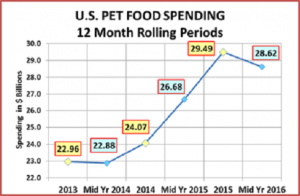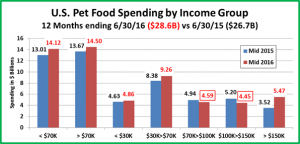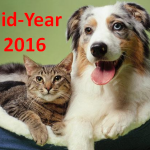U.S. Pet Food Spending $28.6B (↑$1.94B): Mid-Year 2016 Update
The US BLS just released their Mid-Year Update of the Consumer Expenditure Survey covering the period 7/1/2015 to 6/30/2016. The report shows Pet Food Annual Spending at $28.62B (Food & Treats). The following charts and observations were prepared from calculations based upon data from that report and earlier ones. The first chart will help put the $28.6B into perspective with recent history.
- From 2013 to 2015 the Pet Food Segment grew from $23B to $29.5B – a $6.5B (28.3%) increase in 2 years!
- Most of the increase occurred from 2014-2015 when spending reached $29.5B – a $5.4B (22.4%) increase
- First half of 2015 – Up $2.6
- Second half of 2015 – Up $2.8B
- Mid-Year 2015 ($26.7B) vs Mid-Year 2014 ($22.9B)Up $3.8B
- Mid-Year 2016 ($28.6B) vs Mid-Year 2015 ($26.7B)
- Up $1.9B
- July>Dec 2015 – Up $2.8B
- Jan>Jun 2016 – Down $0.9B
2015 was the critical year. It produced the tremendous lift in spending due to the move to upgrade to Super Premium, which was primarily driven by the Baby Boomers. However, 2015 was a unique year in another way too. There was a radical increase in Food Spending and at the same time, the biggest deflation since they began keeping records back in 1997. These don’t usually go together since you don’t buy more food just because it’s cheaper. Perhaps the brands that were losing consumers to the Super Premium Foods were trying to “buy them back”. The result was we had the huge lift due to the upgrade at the same time that everyone else was paying less for their regular food. This appears to have created a value shopping mentality in that the consumer was looking for the best price in other retail outlets and the internet. The deflation continued through the first half of 2016 and so did the pricing scramble.
Let’s see where the $28.6B came from – First by Age Group
- The 55>64 Age group, which is all Baby Boomers is still driving the mid-year increase – Up $2.95B
- You also see the influence of the youngest Boomers in the small lift in the 45>54 Age Group.
- The 65>74 age group is a different story. This group, who originally bought into the Food Upgrade, appears to have backed off a bit.
- The 25>44 age group was the first to try upgrading Food in the second half of 2014 which started the “lift”. In 2015 they backed away. The drop you are seeing is primarily a result of that.
- At the extreme edges of the Age Spectrum, it appears that the Under 25 group is adding pets and the over 75 folks are maintaining them.
Now let’s look at Spending by Income Group:
- Pet Food Spending is almost evenly divided between CU’s earning < $70K and those earning >$70K
- This upgrade to Super Premium was not strictly about money but more about the benefit to your Pet.
- The biggest decrease is coming in the mid to upper income groups. This seems unusual but it is still reflective of the roll back from Super Premium in the 25>44 age group that occurred in 2015.
- You can see that the Under $70K group (Note: Avg U.S. Income is $73K) and the super high incomes are driving the increase. The >$150 is certainly not all Baby Boomers. We may have a new convert to Super Premium.
Comments
Mid-Year 2016 Pet Food Spending totaled $28.62B, an increase of $1.94B (7.3%). That is excellent but I’m sure the question on everyone’s mind is what about the $0.88B decrease in the first 6 months of 2016? What does that mean? Unfortunately, there is no absolute answer. The huge $5.4B lift in Food in 2015 came primarily from the upgrade in Food by Baby Boomers. In fact, their increase was closer to $5.8B so they made up for declines in other groups.
When a large group makes a major change like switching to Super Premium, not everyone will stick with it. You will undoubtedly see some slippage. In the first half of 2016, the 55>64 age group spent slightly less than in 2015 – $0.19B. The Retired group spent a lot less – $0.9B.
There is another factor at work here in the decline in spending in the first half of 2016 which affects everyone…deflation. There was strong deflation in Pet Food Prices for all of 2015 and this continued into the first half of 2016. Even if you are loyal to your Pet Food Brand, why would you pay more than you have to? In today’s world, price comparison is much easier and the internet is now a real option for Food as well as Supplies. Consumers did their homework and paid less.
So what will happen in the second half of 2016? Will there be a net increase in spending for 2016 over 2015? The answer is of course, no one knows.
For 2016 to show an increase over 2015, consumers would have to spend $0.9B more in the second half of 2016 than they did in the second half of 2015, which was the largest second half of all time. Deflation ended in July of 2016 but without a move to Super Premium by a significant demographic segment(s) an overall increase for 2016 seems unlikely. We’ll wait and see. Don’t be overly concerned. In reviewing 30 years of Pet Food Spending history I have noted that there are periodic plateau years where spending slows or even declines slightly, only to bounce back with a renewed vigor. Recent Plateau years occurred in 2013, 2010, 2006, 2003, 2000 and 1997. Pet Food will come back strong, either in the second half of 2016 or in 2017. It always has. Here are some demographic segments that showed strength and increased Pet Food spending in the first half of 2016:
- $150K – ↑$0.59B
- Total Wage & Salary Earners – ↑$0.54B
- 25>34 yr Age Group – ↑$0.41B
- Hispanics, African Americans & Asians – ↑$0.66B
- Homeowners with Mortgages ↑$0.63B
- Center City ↑$0.72B






